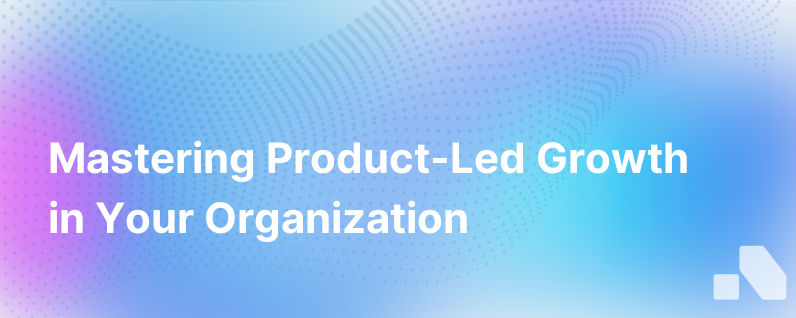Applying Product Led Growth To Your Organization
Published on August 13, 2023 by Sawyer Middeleer
The shift towards a product-led growth (PLG) strategy has been gaining substantial traction in the tech and wider business sphere. It represents a paradigm shift in how organizations approach growth, focusing on leveraging the product itself as the primary driver of customer acquisition, conversion, and expansion.
Transforming your organization to be product-led requires more than just a great product; it necessitates a profound cultural and operational overhaul that permeates sales, marketing, and product development teams. In this article, we'll explore the ins and outs of applying product-led growth within your organization.
Understanding Product-Led Growth
Product-led growth is a go-to-market strategy where the product is the primary vehicle for acquiring, activating, and retaining users. PLG companies bake user acquisition, expansion, conversion, and retention right into the product. It's characterized by:
- Self-service: Allowing users to try or purchase products on their own without prolonged sales processes.
- Virality: Encouraging user adoption through network effects or inherent product referrals.
- User experience: Providing an intuitive and seamless interaction with the product, often delighting users.
- Feedback loop: Continuously iterating on user feedback to improve the product.
- Customer success: Ensuring that users achieve their desired outcomes which naturally leads to product growth.
The Benefits of Product-Led Growth
- Scalability: PLG models can quickly scale as the product's usage spreads organically amongst users.
- Lower Customer Acquisition Costs (CAC): Reliance on the product for user acquisition cuts down sales and marketing overheads.
- Faster Sales Cycles: Self-service capabilities and positive user experiences can shorten the time from trial to purchase.
- Increased Revenue: A satisfied user in a PLG model is more likely to upgrade or expand their use of the product, leading to better retention and upsell opportunities.
Applying Product-Led Growth To Your Organization
Transitioning to a product-led growth model is no small feat. Here’s how organizations can do it successfully:
1. Cultivate a Product-First Culture
Embed a product-oriented mindset at all levels. Every team should understand how the product works and the value it provides to customers. This involves:
- Embedding product training into your onboarding processes.
- Encouraging cross-team collaboration to break down silos between departments.
- Incentivizing teams based on product usage and customer success metrics.
2. Refine Your Product Experience
Your product should be inherently useful and easily adopted without significant hand-holding. This involves:
- Streamlining user onboarding to reduce friction points.
- Creating intuitive interfaces and providing help resources within the product.
- Incorporating user feedback loops for continuous improvement.
3. Adopt a Data-Driven Approach
A successful PLG strategy relies heavily on data. This requires:
- Implementing robust analytics to understand user behaviors and preferences.
- Using data to personalize the user experience.
- Analyzing product usage patterns to identify upsell and cross-sell opportunities.
4. Optimize for Virality and Network Effects
To leverage the product as the primary growth driver, focus on virality:
- Incorporate sharing features within the product to encourage referrals.
- Develop features that foster collaboration between users, encouraging invites to new users.
- Offer incentives for users to share the product within their network.
5. Align Sales and Marketing with PLG
Sales and marketing efforts should support and enhance the product-driven growth model:
- Tailor sales and marketing strategies that align with the self-service model.
- Produce content that educates users about the product.
- Nurture leads based on product engagement and usage, not just marketing qualified leads (MQLs).
6. Foster Customer Success
For PLG models, customer success is pivotal as it fuels retention and expansion:
- Build a customer success team that supports users at critical touchpoints.
- Use product usage data to proactively solve customer challenges and drive value.
- Encourage upsells by helping customers achieve more with your product.
7. Iterate and Innovate
Continuous innovation keeps your product ahead of the curve:
- Encourage a culture of experimentation and rapid iteration.
- Leverage data to drive product decisions.
- Implement agile development practices to swiftly respond to user needs.
Implementation Challenges
While the benefits of PLG are clear, organizations can encounter challenges when shifting towards this model, including:
- Overcoming resistance to change, particularly from teams accustomed to traditional growth models.
- Managing the balance between automated self-service and human touch, especially for complex products.
- Building a robust analytics infrastructure capable of powering a data-driven PLG strategy.
Conclusion
Product-led growth represents a strategic commitment to deliver a product that sells itself. It requires organizations to recalibrate towards a model where the product is not only the value proposition but also the vehicle for customer acquisition, growth, and retention.
When implemented correctly, a PLG strategy can yield improved customer experiences, lower acquisition costs, and a stronger competitive edge. It's a formidable strategy in a world where the user's experience with your product is far more persuasive than any sales pitch ever could be.
To successfully embed product-led growth principles in your organization, leadership must champion the transition, cultivating a product-first culture and continuously iterating based on user data and feedback. With these foundations in place, a product-led growth model can transform your company's trajectory, creating sustainable growth driven by the product itself.